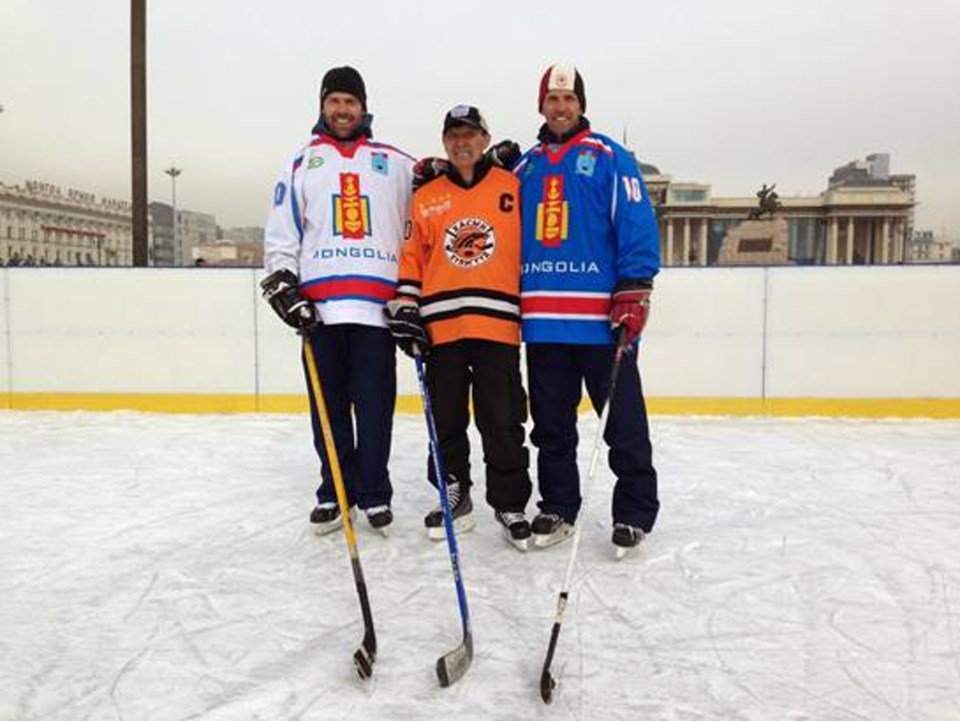If there's a name in hockey you should know but don't — and believe me, you don't know it — it's Pujee.
Purevdavaa "Pujee" Choijiljav is his country’s grandfather of hockey and, as the general secretary of the Mongolian Hockey Federation, is the sentimental star of a new Canadian documentary called Rinks of Hope: Project Mongolia.
The doc hasn’t been widely released yet — they are looking for a distributor and to join the festival circuit — but I saw a screening Monday at Vancity Theatre. The 42-minute doc is written and directed by Karin Larsen, a CBC sportscaster (who now covers technology since the heart-breaking, IMO, demise of the broadcaster’s sports desk) and who is also a hockey mom whose two children both played for a Vancouver coach by the name of Nate Leslie.
A former professional player in Europe, Nate and his brother Boe run an international hockey skills and leadership training service called Leslie Global Sports. The brother is based in New York City, and I wrote a full making-of-the-movie story for the Courier.
The documentary is told chronologically, beginning on Day One of a five-day road trip through northern and rural Mongolia to seven of the country’s 10 ice rinks. All rinks are outdoors because hockey is an outdoor sport, we learn. The sights and sounds of a frozen game are beautiful. Wherever there is a rink, hockey is a cultural anchor.
It’s also a man’s game. The film doesn’t ask why girls or women don’t play sport, but traditional gender roles are maintained, especially as one gap-toothed, hipster-haired prospect tells the camera he celebrates hockey for the same reasons Mongolian men prize horseracing, archery and wrestling. Grinning, he more or less says, “I like hockey. It’s a man’s game.”
The filmmakers aren’t in Mongolia to challenge the patriarchy. And the hockey players are challenged enough as it is.
Back to Pujee. In a country that once counted 17 rinks and twice today's 600-or-so registered adult male hockey players, resources are scant, ice maintenance is rudimentary, glacial temperatures crack blades and keep players closed up indoors, and equipment can only be bought over the Siberian border some 10 hours from the capital Ulaanbaatar, a sharp irony, as one of the Leslies points out, because most of it is made across a different border, the one with China. Pujee grew up watching Soviets play in their after-work leagues, and the filmmakers identify him as one of Mongolia’s first “rink rats,” a child who idolizes the bigger, faster skaters who set an example and set his heart on hockey.
Rinks of Hope: Project Mongolia documents Pujee’s new endeavour to grow youth hockey in his country. A third of the one million inhabitants of Mongolia are under the age of 18, and as Nate Leslie told me, the kids are so fierce that they’re playing style is borderline reckless. And none of the tykes left practice, even in minus-20 degree weather, except when the coaches called it a day.
Going back about a decade, Pujee was playing for the Mongolian men’s national hockey team. It officially formed in May 1999 and was not immediately ranked last by the IIHF as it is now. They played their first international tournament at the 1999 Asian Winter Games hosted by South Korea. Competing inside for the first time in their lives, the players later complained about slogging wetly along in sweaty pads and sweaters.
Mongolia wasn’t the worst team there. While they gave up a combined 54 goals in their Group A round robin against Kazakhstan and the host Koreans, the Kuwaitis allowed 79 goals against opponents Japan and China. In at least one stats column, the two worst teams were deadlocked in goals-for with one each. When Kuwait and Mongolia met in a consolation game at Gangneung on Feb. 5, 1999, our Mongol heroes prevailed 5-4 in overtime. Pujee scored the tying goal to force an extra frame.
This story comes up in the Canadian documentary. Pujee is still determined to develop youth hockey in Mongolia, starting where he lives in Ulaanbaatar. He built a rink with his own money and hands, eventually making it the home for Otgon Od, a hockey club whose name translates to little star and has the emblem of a speeding horse on orange jerseys. They won a lot. But following a dispute with a former friend — emphasis on former, and by dispute I mean theft — the outdoor ice rink is now an uncovered dirt parking lot, its entry barred by the boards Pujee installed plus the addition of a chain and a rental fee.
It’s a crushing turn in the story of his life, and I hope the filmmakers follow that narrative as well as the legal proceedings in a follow-up documentary about the man who first invited them to Mongolia.
To learn more about the documentary, including future screenings, and to donate equipment or money to support youth hockey in Mongolia, visit the project’s page on Kickstarter.



